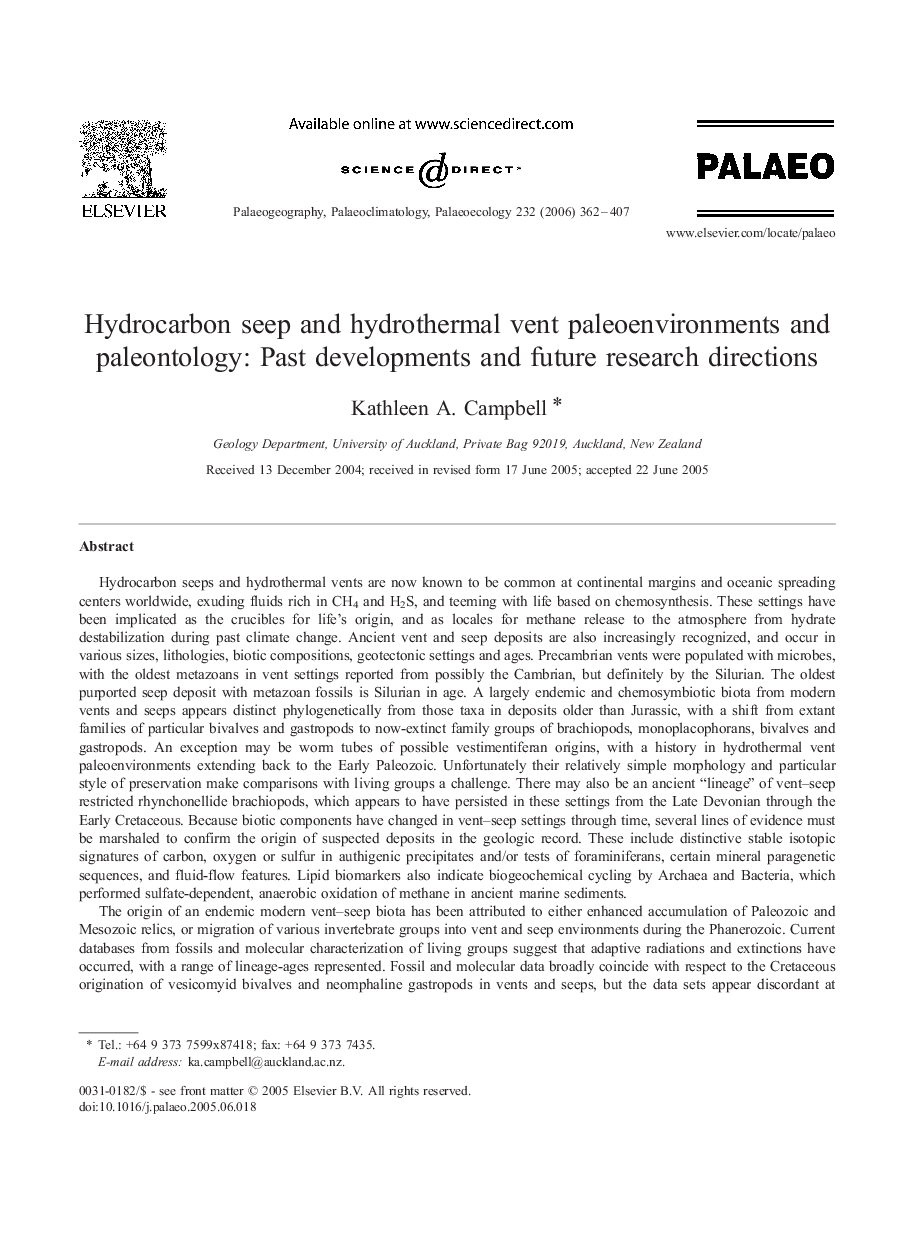| کد مقاله | کد نشریه | سال انتشار | مقاله انگلیسی | نسخه تمام متن |
|---|---|---|---|---|
| 4469608 | 1622377 | 2006 | 46 صفحه PDF | دانلود رایگان |

Hydrocarbon seeps and hydrothermal vents are now known to be common at continental margins and oceanic spreading centers worldwide, exuding fluids rich in CH4 and H2S, and teeming with life based on chemosynthesis. These settings have been implicated as the crucibles for life's origin, and as locales for methane release to the atmosphere from hydrate destabilization during past climate change. Ancient vent and seep deposits are also increasingly recognized, and occur in various sizes, lithologies, biotic compositions, geotectonic settings and ages. Precambrian vents were populated with microbes, with the oldest metazoans in vent settings reported from possibly the Cambrian, but definitely by the Silurian. The oldest purported seep deposit with metazoan fossils is Silurian in age. A largely endemic and chemosymbiotic biota from modern vents and seeps appears distinct phylogenetically from those taxa of deposits older than Late Jurassic, with a shift from extant families of particular bivalves and gastropods to now-extinct family groups of brachiopods, monoplacophorans, bivalves and gastropods. An exception may be worm tubes of possible vestimentiferan origins, with a history in hydrothermal vent paleoenvironments extending back to the Early Paleozoic. Unfortunately their relatively simple morphology and particular style of preservation make comparisons with living groups a challenge. There may also be an ancient “lineage” of vent–seep restricted rhynchonellide brachiopods, which appears to have persisted in these settings from the Late Devonian through the Early Cretaceous. Because biotic components have changed in vent–seep settings through time, several lines of evidence must be marshaled to confirm the origin of suspected deposits in the geologic record. These include distinctive stable isotopic signatures of carbon, oxygen or sulfur in authigenic precipitates and/or tests of foraminiferans, certain mineral paragenetic sequences, and fluid-flow features. Lipid biomarkers also indicate biogeochemical cycling by Archaea and Bacteria, which performed sulfate-dependent, anaerobic oxidation of methane in ancient marine sediments.The origin of an endemic modern vent–seep biota has been attributed to either enhanced accumulation of Paleozoic and Mesozoic relics, or migration of various invertebrate groups into vent and seep environments during the Phanerozoic. Current databases from fossils and molecular characterization of living groups suggest that adaptive radiations and extinctions have occurred, with a range of lineage-ages represented. Fossil and molecular data broadly coincide with respect to the Cretaceous origination of vesicomyid bivalves and neomphaline gastropods in vents and seeps, but the data sets appear discordant at present for vestimentiferan tubeworms and bathymodiolin bivalves. Paleobiogeographic patterns are just beginning to emerge from studies of vent and seep fossils, and are likely to reflect past plate tectonic configurations, sea-level change, as well as the history of organic matter accumulation, burial, hydrocarbon generation, and fluid migration with time. Thus far, ancient hydrocarbon seep deposits yield more diverse fossils than hydrothermal vent deposits, the opposite of the global diversity recently tabulated for modern vent–seep species. However, in the fossil record, taphonomic processes negatively impacted on ancient vent organisms, and the number of known ancient vent systems is still relatively few compared to regional occurrences of ancient seep deposits. Future research will likely investigate many new/suspected sites, inventory numerous additional taxa, decipher underlying causes of variability among settings, and mobilize biologists and geologists to work together to solve problems that cross both disciplines.
Journal: Palaeogeography, Palaeoclimatology, Palaeoecology - Volume 232, Issues 2–4, 22 March 2006, Pages 362–407